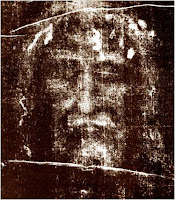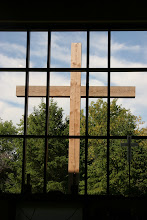I bet I know what he looks like to you. It’s probably the same image that comes to my mind. There are no pictures of the real face of Jesus. Legend tells us that Luke may have been an artist, and that he may have drawn a picture of Jesus but nobody has ever found anything to prove that. Even though we think we know what Jesus looked like, the truth is that we really have no idea.
And why do we even want to know?
In her song “What if God Was One of Us,” Alanis Morissette imagines, “What if God was one of us, just a slob like one of us, just a stranger on the bus, trying to make his way home…”
It is in the incarnation, God’s word, Jesus, who was made flesh and who lived among us, that the words to this song are true. In the person of Jesus, God was one of us.
God came to earth and for a short time, joined the human race. He was born, he was a member of a family, and he had a job. He had to eat and sleep, and pray and travel. He was scared and happy and angry. He loved his friends. He was truly human, and so we believe that he was just like us, just a slob like one of us, just a stranger on the bus…
There was just one difference – Jesus was also truly divine. At Christmas time, we hear Jesus called Emmanuel, a word which means “God with us.” Jesus was one of us, and while he was here, the people that he met were face to face with God.
So what did they see? Our image of Jesus, and the image of Jesus for each person in the world who believes in him, is the image that helps each of us to relate to and to form a connection with this part of the Holy Trinity, that is, God with us.
A few years ago, some British scientists, assisted by Israeli archeologists, used forensic anthropology to create a model of what Jesus might have really looked like. Words from
 Matthew’s gospel offer a clue to the fact that Jesus wasn’t a tall, light skinned, blue eyed western looking man. He looked like the rest of his disciples. We know this, because in order for the soldiers to arrest Jesus in the Garden of Gethsemane before the crucifixion, Jesus had to be indentified by Judas. Jesus looked like everyone else, a typical Galilean Semite.
Matthew’s gospel offer a clue to the fact that Jesus wasn’t a tall, light skinned, blue eyed western looking man. He looked like the rest of his disciples. We know this, because in order for the soldiers to arrest Jesus in the Garden of Gethsemane before the crucifixion, Jesus had to be indentified by Judas. Jesus looked like everyone else, a typical Galilean Semite.For me, and maybe for you, it doesn’t really matter what Jesus looked like. When we imagine Jesus sitting next to us, when we share our worries and our sorrows and our successes and our joys with him in our prayers, Jesus looks like each one of us. He was here, on this earth, for each one of us, and he died for each one of us, and because he rose from
 the dead, each one of us will have eternal life.
the dead, each one of us will have eternal life.




If you are interested in some new ideas on the Trinity as a framework for looking at religions, please check out my website at www.relgiouspluralism.ca. It previews my book, which has not been published yet and is still a “work-in-progress.” Your constructive criticism would be very much appreciated.
ReplyDeleteMy thesis is that an abstract version of the Trinity could be Christianity’s answer to the world need for a framework of pluralistic theology.
In a constructive worldview: east, west, and far-east religions present a threefold understanding of One God manifest primarily in Muslim and Hebrew intuition of the Deity Absolute, Christian and Krishnan Hindu conception of the Universe Absolute Supreme Being; and Shaivite Hindu, Buddhist, Taoist apprehension of the Destroyer (meaning also Consummator), Unconditioned Absolute, or Spirit of All That Is and is not. Together with their variations and combinations in other major religions, these religious ideas reflect and express our collective understanding of God, in an expanded concept of the Holy Trinity.
The Trinity Absolute is portrayed in the logic of world religions, as follows:
1. Muslims and Jews may be said to worship only the first person of the Trinity, i.e. the existential Deity Absolute Creator, known as Allah or Yhwh, Abba or Father (as Jesus called him), Brahma, and other names; represented by Gabriel (Executive Archangel), Muhammad and Moses (mighty messenger prophets), and others.
2. Christians and Krishnan Hindus may be said to worship the first person through a second person, i.e. the experiential Universe or "Universal” Absolute Supreme Being (Allsoul or Supersoul), called Son/Christ or Vishnu/Krishna; represented by Michael (Supreme Archangel), Jesus (teacher and savior of souls), and others. The Allsoul is that gestalt of personal human consciousness, which we expect will be the "body of Christ" (Mahdi, Messiah, Kalki or Maitreya) in the second coming – personified in history by Muhammad, Jesus Christ, Buddha (9th incarnation of Vishnu), and others.
3. Shaivite Hindus, Buddhists, and Confucian-Taoists seem to venerate the synthesis of the first and second persons in a third person or appearance, ie. the Destiny Consummator of ultimate reality – unqualified Nirvana consciousness – associative Tao of All That Is – the absonite* Unconditioned Absolute Spirit “Synthesis of Source and Synthesis,”** who/which is logically expected to be Allah/Abba/Brahma glorified in and by union with the Supreme Being – represented in religions by Gabriel, Michael, and other Archangels, Mahadevas, Spiritpersons, etc., who may be included within the mysterious Holy Ghost.
Other strains of religion seem to be psychological variations on the third person, or possibly combinations and permutations of the members of the Trinity – all just different personality perspectives on the Same God. Taken together, the world’s major religions give us at least two insights into the first person of this thrice-personal One God, two perceptions of the second person, and at least three glimpses of the third.
* The ever-mysterious Holy Ghost or Unconditioned Spirit is neither absolutely infinite, nor absolutely finite, but absonite; meaning neither existential nor experiential, but their ultimate consummation; neither fully ideal nor totally real, but a middle path and grand synthesis of the superconscious and the conscious, in consciousness of the unconscious.
** This conception is so strong because somewhat as the Absonite Spirit is a synthesis of the spirit of the Absolute and the spirit of the Supreme, so it would seem that the evolving Supreme Being may himself also be a synthesis or “gestalt” of humanity with itself, in an Almighty Universe Allperson or Supersoul. Thus ultimately, the Absonite is their Unconditioned Absolute Coordinate Identity – the Spirit Synthesis of Source and Synthesis – the metaphysical Destiny Consummator of All That Is.
For more details, please see: www.religiouspluralism.ca
Samuel Stuart Maynes